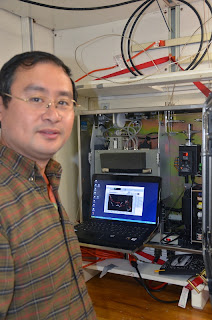Hi, I’m Elliott. I'm the newest addition to the science party, and am working alongside Zhaohui ‘Aleck’, Sophie, Katherine, Kelly, and Nick on the Chemistry team. Unfortunately Britta Voss could not make it to join us for the 3rd leg of the NH1208 journey, so I took over her duties on the ship.
You can refer to blog posts from our last year's cruise for additional information on ocean acidification and how we study it, but here is a brief review of what the chemistry crew are researching:
Sophie hard at work conducting science
In the ocean, CO2 (carbon dioxide) is present in the forms of CO2(aq) (i.e., dissolved), CO3-2 (carbonate ion), and HCO3-1 (bicarbonate ion). H2CO3 (carbonic acid) is present as well, but in negligible quantities. These molecules constitute the basis of the seawater carbonate chemistry system and are governed by the following dissociation equations:
CO2 (aq) + H2O ↔ HCO3-1 + H+
HCO3-1 ↔
CO3-2 + H+
The same chemical reactions occur in carbonated beverages, such as soda. But soda water is much more acidic than seawater. Rising CO2 in the atmosphere associated with the burning of fossil fuels is causing more CO2 to dissolve into the ocean, a process that is similar to making water slowly carbonated; this causes an increase of H+ (hydrogen) ion concentration in seawater, decreasing pH (more acidic) and CO3-2. This collective chain of events on a global scale is known as ‘ocean acidification’. The goal of our project is to understand what consequences might ensue from these chemical changes in the marine environment. By comparing our current measurements to those made in previous cruises at similar locations in the ocean, we can also estimate the rate at which the ocean is acidifying.
Ocean acidification can be examined by analysing the carbonate system, which is done by examining those four primary variables that can be measured in the field. The four variables are dissolved inorganic carbon (DIC), total alkalinity (TA), pH, and pCO2 (partial pressure of carbon dioxide, which is proportional to the amount of dissolved CO2). Our chemistry team possesses benchmark technology that measures these parameters.
Aleck fiddling with the Multi-Parameter Inorganic Carbon Analyzer (MICA)
Sophie posing next to the high-caliber total dissolved inorganic carbon models
The Chemistry Lab
This is the Dissolved Inorganic Carbon Analyzer. Can you take a guess at what it does?
DIC is the summation of the dissolved forms of carbon: CO2(aq), CO3-2, HCO3-1 , and H2CO3. What this gadget does is convert all the species of DIC to CO2 in the sample by adding a strong acid (10% phosphoric acid). CO2 gas is then purged out of solution by an inert gas (nitrogen, in the big tank on the left) and the flow takes the CO2 to a drying unit to remove water vapour. The dried CO2 concentration is determined by using the LI-7000 CO2 (infrared) analyzer (this is within the machine).
This is the Alkalinity Titrator. Can you take a guess at what it does?
Total Alkalinity (TA) is a conservative quantity, which stays constant with changing pressure and temperature, and is defined as the amount of acid required to nullify all of the bases currently in solution to the CO2 equivalence point (pH 4.5). It is summed up in this equation:
These are the dominant species in TA.
↙
TA = [HCO3-] + 2[CO3-2] + [B(OH)4-] + [OH-] + [HPO4-2] + 2[PO4-3] + [SiO(OH)3-] + [NH3] + [HS-] - [H+] - [HSO4-] - [HF] - [H3PO4] + [minor bases – minor acids]
TA is obtained via a titration with a strong acid (in our case, hydrochloric acid). This is what we would like to determine within a water sample.
This Agilent device shown above is a spectrometer. This machine can determine pH with high precision (to 3 units past the decimal place) via measuring the light intensity (over a UV spectrum) of the sample.
The Titrando system above measures dissolved oxygen content within a seawater sample. As Amy said in an earlier post, measurements of oxygen enables the biologists on board to understand more about the metabolic rate of pteropods in the North Pacific (the target organism of this cruise).
A Happy Aleck because the MICA is working
This is MICA (Multi-Inorganic-Carbon-Analyser; Aleck’s pride and joy). This puppy can simultaneously measure DIC, pH, and pCO2 of both air and seawater! This is used to measure underway water (sea surface samples) every few minutes.
The underway pCO2 system.
This General Oceanics machine is called 'Live pCO2', and it measures underway pCO2 of air and seawater as well.
Elliott out.
(A big thanks to Peter Wiebe for lending his camera to contribute images for this post)












i have limited or no knowledge about ocean acidification but i'm interested in learning about it.. Good thing there's a blog like this. it's informative and fun at the same time.
ReplyDeleteWe offer personal loans up to $ 100,000, are you looking for a business loan and have been denied by a bank, we can help with loans of $ 5,000 to a maximum of $ 100,000.loans that can help you start your dream business,Rebuild and get your business back on track and can also bring you on a path to a better financial future.On time, you can apply in just a few minutes and get your money the same day.
ReplyDeleteDo not delay! E-mail via {smallscaleloans@gmail.com}
Thank you for contacting us,
Best regards
Mr.George
smallscaleloans@gmail.com